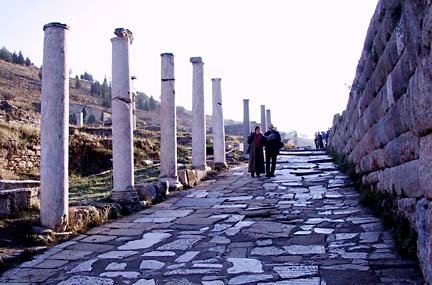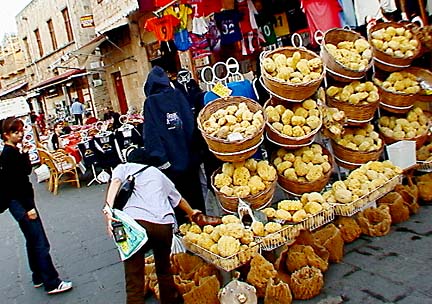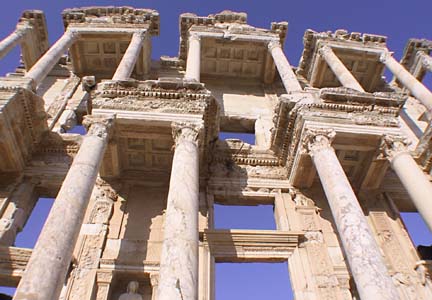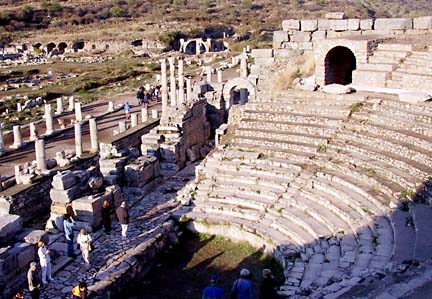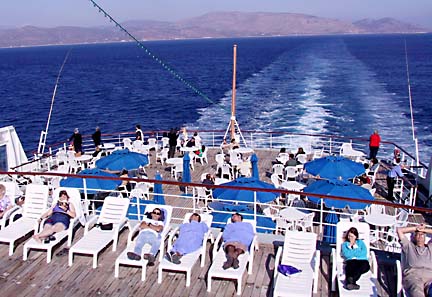
[ SUNDAY TRAVEL ]
DENNIS CALLAN / SPECIAL TO THE STAR-BULLETIN
People walk through the ruins in the noble Turkish town of Ephesus.
Explore quaint Greek and
Turkish isles in the Aegean SeaTravel information
[ 3 Days In... ]
By Dennis CollanThe magic AND romance of the Greek isles of Mykonos, Rhodes and Patmos can be yours, along with the enchantment of Ephesus, Turkey, in a short cruise across the Aegean Sea. To get around this part of the Mediterranean, you can fly, go by ferry or, best of all, take a cruise.
Cruising is the hassle-free way to see the Greek islands. A three-night trip, booked through Royal Olympic Cruise Lines, will take you to the most attractive sites, free of logistical headaches. The downside is the limited time allotted for shore visits, but you can see many fascinating sights by walking in the right places.
Summer is the high season for tourists. The low season is in spring and fall. Nearly all the shops and restaurants are closed from November through mid-March. Summer is most popular, especially for young sun-seekers, but temperatures often reach the upper 90s.
The islands have a split personality, according to the season. In spring and fall, they are tranquil, but in the heat of summer they are full of drunken college kids.
DENNIS CALLAN / SPECIAL TO THE STAR-BULLETIN
Children on the Greek isle of Mykonos don costumes for the annual Independence Day parade on March 25.

Cruising to Mykonos and exploring the island
The cruise begins from Piraeus harbor outside Athens at 11 a.m. Take a taxi for the 40-minute ride to the terminal, or go by metro from Athens.Cruising is sheer pleasure and self-indulgence, and the ship's crew is Greek, so you are immersed in the culture from start to finish.
As the ship pulls away from Piraeus, stay on deck for a view of the busy harbor, for there will be few other sights as you head across open water. Travel conditions are calm on the Aegean Sea on a ship with effective stabilizers.
Most of the first day will be spent cruising to Mykonos. This gives you seven hours in which to relax and do nothing. Of course, the first activity is eating lunch, with a choice of an outdoor buffet or indoor dining. When the weather is fair, dining al fresco lets you enjoy fresh sea air. Dinner is always served indoors.
>> Mykonos: With its quaint village of cubic buildings against the shore, Mykonos is a Mediterranean dream. The beauty of this little town has made Mykonos one of the world's most attractive islands. The town of just a few thousand is a harmonious structure of white, two-story buildings with colorful trim, connected in rows, and linked by a network of pedestrian lanes. Often compared to a honeycomb, this living labyrinth will delight you. Noted architect Le Corbusier, a founder of modern design who admired this village, concluded that "whatever architecture had to say, it said it here."
The ship arrives at about 6 p.m. and departs at 10 p.m., so you need some effective maneuvers to get the most out of your visit. Depending upon weather and traffic, you will either transfer to shore by tender, a small craft that pulls into the dock, or the cruise ship will tie up at the harbor and you will go by bus. Either way, you arrive at a waterfront that is lined with outdoor cafes.
This tiny town is a maze of pedestrian alleys that wind through the clusters of shops and homes. You could get disoriented, but you can't get too lost because the town is only 400 yards wide and 500 yards deep, bounded by water on two sides, with a steep hill on the edge. Cars are prohibited, but watch out for the motor-scooter pickup trucks.
DENNIS CALLAN / SPECIAL TO THE STAR-BULLETIN
Merchants sell their wares on the street on the island of Rhodes.
The cruise schedule doesn't provide much time so focus on the sights and shops, and take time for a drink at one of the charming cafes. This village is so small that you can see most of it in two hours. The rest of the island, which is only 10 miles long and seven miles wide, has few other sights, save for some topless beaches.
There might be an awesome sunset over the sea, so sit at a sidewalk table for the natural light show. Try the local wine, a pink rosé. It's amazing that such a dry island still has vineyards producing local wines.
The little harbor is a treasure-trove of fishing boats, scattered at anchor or tied to the pier. You might even spot the town mascot, a pelican, and a gaggle of ducks. Shoppers will find jewelry stores and art galleries throughout the village. Souvenir hunters will find Mykonos T-shirts, guidebooks and postcards, but there is not much else to buy.
>> Walking route: There is one main lane on each side of town connected by a street at the back, so all you need to do is follow this U-shaped path into the village, across to the other half of town, and back to the waterfront. This way you can see all the main sights, with time for shopping and a drink.
The maze of lanes is large enough to keep you exploring for hours. Following the U-shaped route, wander into the side alleys. Some have shops, while others are residential lanes with a lot of character.
From the waterfront, walk along the shore to the taxi stand at Manto Square. Turning inland, several lanes will branch off. To reach the main shopping lane, Matogianni, veer toward the church of St. Kyriaki. These "streets" are too narrow for cars, but they are lively promenades.
DENNIS CALLAN / SPECIAL TO THE STAR-BULLETIN
Visitors explore ruins on Rhodes, which dates to the Trojan Wars of 1200 B.C.
You are now in the middle of "downtown" Mykonos, so wander along two other small shopping lanes that run parallel to Matogianni. There are few street signs here so the trick is to follow your nose and ears.
At the end of the main lane, turn on Enoplon Dinameo, which will take you to the other side of town. Toward the end of this lane you will see two tiny restaurants that feature gyros sandwiches, souvlaki or salads at low prices. A block over is the lively crossroads with Mitropoleos, the main shopping lane that leads you back to the waterfront in 10 minutes.
You can then go back to the harbor or walk uphill for more exploring. Or you can take Mitropoleos, which twists and turns, then ends up at the sea.
There are some interesting diversions uphill, such as three short parallel lanes with more shops and snack bars, and an authentic restaurant, the Marco Polo. After a few blocks you will reach streets with cars buzzing by. Turn on Xenias Street, and go to the famous symbol of Mykonos, the row of five windmills overlooking the town. At one time there were 16 windmills, powered by the steady winds to grind grain; now only a few remain as nonfunctioning, majestic landmarks.
Take the long staircase down to the coast for a scenic view toward "Little Venice." There are no canals or gondolas, but these old buildings teetering on the water's edge look as if they rise directly out of the sea. Several cafes have tables on the terrace, making a nice perch from which to enjoy the view. A traditional taverna famous for fish and typical Greek dishes, Alefkandra, is here on the water's edge. Two blocks inland is a popular restaurant, Nikos, serving delicious Greek food.
Look for the irregular-shaped white church of Paraportiani, a major landmark. It consists of five little chapels with curved vaults and colored cupolas that meld in a unique, curved ensemble. There are about 360 tiny chapels in the village, built by superstitious sailors and their families hoping for good luck at sea. Greek Orthodox is the national religion.
Kick back at a cafe before returning to the ship for a late dinner, entertainment in the lounge and an overnight voyage to Rhodes.
Consider arriving in Mykonos a few days early by ferry or air, staying on the island for a few nights, then joining the cruise ship to continue with the rest of this itinerary.
An attraction for those staying longer is the island of Delos, filled with archaeological remains from its Golden Era as a trading and spiritual center of Greece. Delos, which can be reached in 30 minutes by ferry from Mykonos, had an important history that lasted from about 1,500 B.C. through the Roman era. Uninhabited, it is now a national historical park with a small museum.
Those visiting in summer might check out the topless beaches: Platys Yialos, Paradise and Super Paradise. Mykonos is also famous for wild parties in its many bars, which start at about 11 p.m. and last until morning.
DENNIS CALLAN / SPECIAL TO THE STAR-BULLETIN
Traditional garb of Greek Orthodox clergy includes black cassocks, 'chimney-pot' hats, long hair and long, untrimmed beards.

Cruising to Rhodes and going back in time in the Old Town
The cruise ship arrives early the next morning at Rhodes. It is worth being on deck to witness the ship's entry into this ancient harbor. After breakfast on board you will have a day to explore the town. There is an optional tour to Lindos, an hour's drive to a small village, with sparse ruins of an ancient Greek temple on the hill. However, you could easily skip Lindos and transport yourself several centuries back in time strolling through the narrow lanes of the Old Town, a UNESCO World Heritage Site.Rhodes dates to the Trojan Wars of 1200 B.C. when, according to Homer, the island sent ships to join the forces attacking Troy. The town was founded as a Greek settlement during the 5th century B.C. and became an important culture and arts center, noted for its fine statues in bronze and marble. When the Roman conquerors arrived, they plundered the island and took thousands of statues to Rome. The island is known for its legendary Colossus of Rhodes, a 100-foot-high statue that was one of the Seven Wonders of the Ancient World, reputedly created in the third century B.C. but toppled by an earthquake a few decades later and sold as scrap.
The next significant development took place in the 14th century, when Rhodes was expanded into a fortress by the Knights of St. John, part of the invading Christian armies of the Crusades. These knights from England, France, Italy and Spain formed a coalition of forces to defend against the Muslim invasion. The Old Town is surrounded by a massive fortified wall. Many of the buildings encircled by the wall are from this medieval period.
Rhodes was besieged by Turkish forces several times, finally falling in 1523 to the invading army of Suleiman the Magnificent, of the Ottoman Empire. A battle raged for months, with 100,000 Turkish troops surrounding the fortified town, which was defended by a few hundred Knights of St. John and their mercenary army of 5,000 troops. This drama has been frozen in stone. Parts of the town have been reconstructed, including the main palace and Street of the Knights, but most of the neighborhoods are untouched, giving them a dilapidated charm.
Turkey ruled Rhodes until World War I, when Italians invaded and occupied the area until World War II. Then the Germans controlled the city until it was liberated by the British, and it was finally reunited with Greece in 1948.
The Old Town of Rhodes is three times larger than Mykonos village, and the buildings are earthy brown.
DENNIS CALLAN / SPECIAL TO THE STAR-BULLETIN
The Greek island of Patmos is famous for the Monastery of St. John, perched atop a hill, surrounded by a charming ancient village and tranquil harbor.
Rhodes is on the sea, but the Old Town is sealed off from the water by a huge defensive wall. You can venture outside the wall to the New Market by Mandraki Harbor, where outdoor cafes offer a view of the docks. Another section worth visiting is the modern downtown, inland from New Market.
>> Walking route: After leaving the ship, go to the gate of St. Mary and pass through it, into the Middle Ages. You will see the ruins of a Gothic church, with pointed arches still holding up the end walls but without a roof, creating a tranquil garden among the rubble. Most of the Old Town is reserved for pedestrians, so the atmosphere is peaceful.
The main street runs the length of Old Town. It winds through a couple of small town squares until it becomes Socratous Street, lined with shops and cafes. Walk past the fountain with the seahorses to Ippokratous Square, then plunge into the residential back lanes.
Walk up the lane of Pythagora into the old Turkish section, which makes up the town's back half. You'll see a tall minaret, standing above the town's oldest Turkish mosque, Ibrahim Pasha Cami, built in 1531 and recently renovated.
The floor is covered in lush carpets, a prayer niche points toward Mecca and Koranic phrases are painted on wall plaques. There are 14 surviving mosques and 28 small Byzantine churches in the Old Town.
Continue up Pythagora to the end at Koskinou Gate. Notice the picturesque stone arches across the alleys, designed to hold the buildings together during small earthquakes.
At the end of Pythagora, go to the gate for a view of the town's elaborate fortification: two parallel stone walls, each 60 feet high and 30 feet thick, separated by two huge dry moats. These structures were built during the age of cannon artillery, with the aim being to build walls so huge that cannon balls would bounce off.
DENNIS CALLAN / SPECIAL TO THE STAR-BULLETIN
Ruins of the beautiful Library of Celcus are in Ephesus, called the most important city in Asia Minor 2,000 years ago.
Return to the Old Town, past the Redjep-Pasha mosque, to the highest stretch of the wall. It leads to another gate, St. Athanasios, which gives a view of the walls and moats.
Continue through the Old Town along Ippodamou, then take the twisting lanes to the Moustafa Mosque and Baths. The mosque is being restored, but the authentic Turkish bathhouse is open to the public.
On the far side of the mosque, take Ergiou through the arch to another quaint street, Agios Fanourios, then go back to Socratous.
Continue up Socratous to the Mosque of Suleiman, the largest in town. Next door you'll see the Clock Tower, which you can climb to gain a bird's-eye view of the town. There are more cafes and shops along this block, leading to the Palace of the Grand Masters.
>> Moat, Palace and Museum: Continue through St. Anthony arch to D'Amboise Gate for views of the fortified entrance. Go back to St. Anthony arch, where a staircase goes through a tunnel to the grassy moat.
You now arrive at the Palace of the Grand Masters, open as a museum. Built during the 14th century, it was headquarters for the Knights of St. John. Unfortunately, occupying Turks stored their gunpowder in the basement and a lightning storm in 1856 set off an explosion that leveled the palace, killing 800 people. It was rebuilt to the original design by the Italians in 1939. There are few furnishings, but there are some interesting sights inside the 205 rooms, including floor mosaics brought from Kos island and dating from the Hellenistic and Roman periods, marble statues, and rooms that create an ambience worthy of medieval aristocracy.
A soaring Gothic loggia built in the early 15th century stands in front of the palace and leads you into the Street of the Knights. It was reconstructed in the early 20th century, and the result is an accurate representation of the headquarters of various nations involved with the Knights. Cobblestone paving and rugged stone masonry of fortified palace facades lining both sides make for a dramatic vista. Several attractions await you at the bottom of the street.
DENNIS CALLAN / SPECIAL TO THE STAR-BULLETIN
Ephesus, Turkey, is the site of wonderfully preserved ancient ruins. Its theater, which can seat 24,000, is still used today.
>> Archaeological Museum: Located inside the Gothic Hospital of the Knights, this is one of the most fascinating sights in Rhodes. This is the original hospital, dating from 1440-81. The Knights of St. John were primarily on a medical mission to care for wounded Christian soldiers, so this hospital was a focus of their activities. It contains many rooms full of exquisite sculptures, especially the marble masterpiece of a nude Aphrodite, goddess of love, and the head of Helios, the sun god.
Upon entering the museum you'll walk into a courtyard surrounded by a two-story stone loggia that resembles a Gothic cloister, with columns and arcades joined by pointed arches. You'll see piles of huge stone balls in the courtyard and scattered throughout town. They were used as sling stones for the huge catapults. Several rooms of pottery and jewels are on the ground floor, but the main collection is on the second level. The long hospital infirmary ward is spacious enough to hold 100 patients.
After emerging from the museum, visit the oldest church in town, St. Mary of the Castle, constructed in the Byzantine style during the 11th century and predating the arrival of the Knights. From here it is just one block to Symi Square and the Freedom Gate, which leads you to the New Town.
>> New Town: Mandraki Harbor, filled with fishing and excursion boats, provides a scenic backdrop for the cafes along the front of the New Market. Pastries displayed here will make your mouth water, and the padded seats on the terrace will lure you to sit for a pot of tea. If you prefer lunch, you will find a meal for a few dollars in the courtyard.
Exit the New Market complex and walk uphill into modern Rhodes. You are back in the land of fancy shops, streets filled with cars, noise, fast food and modern buildings. There's not much to see, except for a slice of modern life. Go back into the Old Town through D'Amboise Gate.
If you're hungry, you could do no better than a meal of fresh fish at Taverne Alexis on Socratous Street. Prices are high but the food is delicious. There are many reasonable places to eat in the Old Town, especially along Pindarou Street and just beyond the Square of the Martyrs with the seahorse fountain. Walking in that direction you will pass through Ippokratous Square again, where you can find a wine store stocked with excellent Rhodian wines. Another site to visit on the square is the Public Library, housed in an authentic Gothic building, complete with medieval courtyard.
DENNIS CALLAN / SPECIAL TO THE STAR-BULLETIN
Ancient alleys weave throughout the Old Town section of Rhodes, and the ban on cars makes the area safe and tranquil for pedestrians to explore. Stone arches were built across the alleys to help stabilize the buildings during small earthquakes.

Cruising to Patmos for a short visit and making a stop on the edge of Turkey to see Ephesus
>> Patmos: After an overnight cruise you arrive early at this little Greek island, where you stay for just three hours. It is worth joining the optional excursion to the one site this island has to offer: the fascinating Monastery of St. John and the village around it, up on a hill a few miles from the port. At the harbor there is only the three-block town, with a few souvenir shops and fishing boats bobbing at the dock.The monastery looks like a fortress, with stone walls towering over the village atop the hill, but this monastery is a holy place where Orthodox priests still carry out rituals and lead devout lives. It is named for St. John the Divine, the disciple who reputedly wrote the Book of the Apocalypse here around 95 A.D.
The monastery was built 900 years ago and includes a church, courtyard, private areas for the monks and a treasury exhibiting ancient manuscripts, mosaics, icons, jewelry and medieval textiles. Inside the Byzantine church you will be overwhelmed by the frescoed murals that cover most of the elaborate surfaces.
Walk back to the bus through the village, rather than along the road. Called the Hora, this is a medieval charmer, with narrow alleys and staircase streets, winding through an ancient residential complex, past houses that have been occupied for centuries. You can't get lost if you keep heading downhill, toward the town square and City Hall, overlooking your bus stop. The bus tour makes a stop at the Cave of the Apocalypse, where St. John reputedly lived while writing the Apocalypse. Then you return to the ship for a three-hour cruise to Turkey, with lunch on board.
>> Ephesus: Now, you get a taste of Turkey. You arrive at the Turkish port of Kusadasi at 1:30 p.m., and your main activity is an excursion to the site of Ephesus, built up by the Greeks and Romans 2,000 years ago as the most important city in Asia Minor. It is one of the best-preserved classical ruins in the world. It includes a long boulevard, a large classical theater, and the beautiful Library of Celcus. The theater is still used today, seating up to 24,000 people in a semicircular structure.
You board a tour bus with a guide, who explains the history while driving to the site and then walks you through the ruins. Guides love to point out the communal toilet and an ad for the town bordello, carved into the marble street. Rows of columns and carved fragments attest to the noble status of this ancient town, which had been a seaport until the harbor filled with silt.
DENNIS CALLAN / SPECIAL TO THE STAR-BULLETIN
Royal Olympic Cruise Lines will take you to the Greek islands' most fascinating sites, free of logistical headaches. The company is the exclusive operator of cruises within Greek waters.
After a few hours exploring Ephesus, the tour returns to the harbor town of Kusadasi. Your guide will invite you into a store for a presentation of Turkish carpets. You will see a dazzling performance, with one colorful carpet after another dramatically unfurled while you sip complimentary tea.
Kusadasi is a small undistinguished town, with a row of tourist shops near the dock, but there is a little pedestrian mall one block inland that gives you a feeling for local life in Turkey. If you need a gift for someone back home, buy some Turkish Delight candy. Enjoy the final night on the ship with dinner and Greek dance. The next morning, your cruise ends when you disembark at Piraeus.
Dennis Callan is the president of the Hawaii Geographic Society and produces the "World Traveler" television series, shown at 8 p.m. Mondays on 'Olelo, channel 52. He frequently leads tours through Europe, and writes "Three Days in ..." the first Sunday of each month explaining how to get the most out of three days in the world's great places. View the companion TV episode this week.
BACK TO TOP |
If you go ...
Here are a few places to stay, beyond the cruise ship, while touring the Greek isles. Use the prefix 011-30 when calling:
HOTELS
Mykonos>> Hotel Leto: Call 2289-0-22207; fax 2289-0-23985; e-mail leto@myk.forthnet.gr
>> Hotel Semeli: Call 2289-0-27466; fax 2289-0-2746; e-mail semeliht@otenet.gr
>> Hotel Ilio Maris: Call 2289-0-23755; fax 2289-0-24309; e-mail iliomaris@otenet.gr; www.iliomaris.com
>> Hotel Belvedere: Call 2289-0-25122-5; fax 22890 25126; e-mail belvedere@myk.forthnet.gr
Rhodes
>> Plaza Hotel: 7 Ierou Lochou St., Rhodes 85 100. Call 241-0-22501; fax 241-0-22544
>> St. Nikolis Hotel: 61 Hippodamou St. (inside the Old Town). Call 241-0-34561; fax 241-0-32034.
WEB SITES
Tour operators>> www.tourlite.com
>> www.royalolympiccruises.comMykonos
>> www.travel-to-mykonos.com
>> www.mykonosgreece.com
>> www.greekislands.com Mykonos
>> www.magicaljourneys.com MykonosRhodes
>> www.helios.gr/Rhodes
>> www.rodos.com
